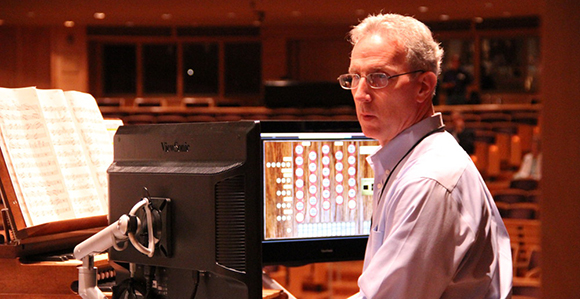New Organ on Choir Tour Simulated Three Large Pipe Organs
Contributed By R. Scott Lloyd, Church News staff writer

Salt Lake Tabernacle organist Richard Elliott, during sound check at the Music Center at Strathmore in Bethesda, Maryland, on June 25, plays the new computerized organ used during the two- week Atlantic Coast tour of the Mormon Tabernacle Choir and Orchestra at Temple Square. The organ has digitally sampled sounds from three major pipe organs.
Article Highlights
- It’s the first time the new organ has been used on a tour of the choir and orchestra.
- The organ console includes two large computer touch screens on either side displaying the knobs representing the various organ stops that are available to an organist.
- Sounds from the three major pipe organs have been incorporated into the instrument through digital sampling.
“This new organ is definitely working very, very well and giving us the signature sound, which is for the choir to have an organ in the picture as well as the orchestra.” —Richard L. Elliott, Tabernacle organist
Three pipe organs were carried along as part of the recently concluded Atlantic Coast tour of the Mormon Tabernacle Choir and Orchestra at Temple Square.
They were the virtual—not the actual—instruments, included within one computerized organ console played at a number of the concert venues by the three Tabernacle organists who accompany the choir. It’s the first time the instrument has been used on a tour of the choir and orchestra, though they have rented such instruments in the past.
“Since we go on tour with the choir at least every two years and have a lot of smaller tours in between, we decided it would be more cost-effective to purchase our own instrument, and with the technology now available, there were some excellent options out there,” said Richard Elliott, one of the three Tabernacle organists, all of whom performed with the choir and orchestra on this tour.
The computerized instrument gives them three options, said Brother Elliott during a break in a sound check June 25 at the Music Center at Strathmore in Bethesda, Maryland, one of the tour venues.
“One is the organ at the Salisbury Cathedral in England, one is an instrument from near Chicago, and the one we’re using most on this tour is from Los Angeles that’s roughly the same size as the Tabernacle Organ and built by the same builder. So we can get a lot of the same sounds that we use at home in the Tabernacle.”
But it’s all software-based. Thus, the organ console includes two large computer touch screens on either side displaying the knobs representing the various organ stops that are available to an organist.
Brother Elliott acknowledged that it takes some getting used to. “But most of it we preprogram,” he said. “We’re using the touch screens very little at this point. We use them mainly when we’re setting up the organ before we go on tour. On tour, we mostly use the white buttons under the keys that feel just like the ones on our home organ.”
The instrument was purchased in early April and has been reinforced structurally because “we’d be taking it on semitrucks for miles and miles, and that tends to vibrate things. So the technicians made sure it was going to be roadworthy, and it is. Everything works like a charm.”
Sounds from the three major pipe organs have been incorporated into the instrument through digital sampling.
“They were created by somebody who went to those organs and put a microphone up to every single pipe on the organ, and that’s a lot of pipes.” Brother Elliott said. “In the case of the one we’re using now, it’s in the many thousands of pipes.
Some of the sounds are created with what is called a “wet sample,” meaning that the microphones are placed farther out into the room so that the acoustics of the room are incorporated into the digitally sampled sound.
With sounds that are “dry sampled,” the microphone is placed closer to the organ pipe with the intent that the acoustic of whatever room the organ is played in will be part of the sound.
In each instance, the organ sound can be refined or adjusted with reverberation or decay by means of a mixing board. This is particularly useful in outdoor locations, which might present some unforeseeable challenges, Brother Elliott said.
The new organ was not used in all of the tour venues. Carnegie Hall, for example has its own organ, which the Tabernacle organists played during the concerts, although the pipe organ that was once at Carnegie was removed during a past renovation.
“That’s kind of a battleground in the organ world,” Brother Elliott said. Consultants at the time determined that it would be best for the sake of acoustics to remove the organ pipes.
“So they now have an electronic organ there, and organists have been resentful for years and years, I think, of having the pipe organ evicted from Carnegie Hall. And there’s some debate whether the organ really was that detrimental to the acoustics in the first place.”
Brother Elliott said that with today’s technology, organ sound even on a portable one such as that used on the tour “is so much better than it was even 20 years ago. And when you combine it with the full sound of the orchestra and the choir, it’s thrilling.”
He said that when he first came on board as a Tabernacle organist, the choir typically used a piano in the halls where it performed when it went on tour. “We’d use an organ if there was a pipe organ in the hall. But now, this new organ is definitely working very, very well and giving us the signature sound, which is for the choir to have an organ in the picture as well as the orchestra.”
